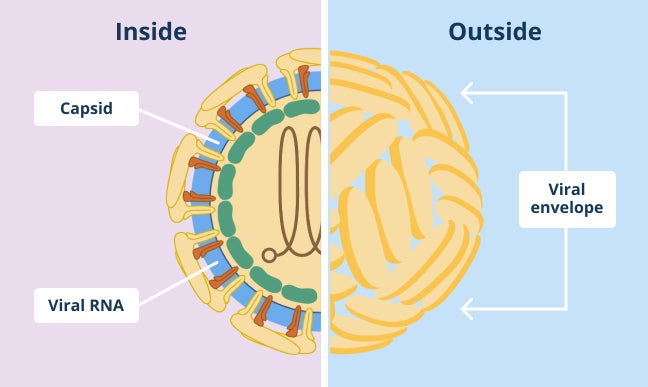What is a virus?
Viruses are very small, simple microbes, but they are capable of causing a great deal of harm to humans.1,2 The diseases that viruses can cause range from mild, such as the common cold or cold sores, to life-threatening, such as liver failure, bleeding disorders, immunodeficiency and even certain types of cancer.1
Despite their ability to cause disease, viruses are the smallest of all microbes: generally around 100 to 1000 times smaller than a single human cell.2 In the outside world, viruses are inactive. They are unable to reproduce by themselves and only come alive when they enter a living being (or host).1-3 Their structure has adapted over many years to enable them to enter host cells, reproduce and spread:2,5,9

At their centre, viruses carry genetic material. This fragile material contains the instructions needed to reproduce inside the host cell.2 There are many hazards in the microscopic world: air flow, liquids, digestive enzymes, ultraviolet radiation and even radioactivity.2 In order to protect the RNA from this harsh environment, the virus surrounds itself with a strong, flexible protein shell, called a capsid, from the Latin ‘capsa’, meaning “box.”2 And around the capsid is a coating made up of protein and fat, called the envelope.2 This is the virus’s disguise; a mask which enables it to enter our cells and evade our immune system.4
How do viruses enter our bodies?
To infect us, viruses must first enter one of our cells at the surface of our body. Common sites of viral entry include the surface of our airway, digestive and urogenital tracts, the eye, and the skin.8 Our skin is usually an effective barrier against viral infections, as the dead outer layer cannot support viral growth.8 Viruses that do enter through the skin, such as the dengue virus, need help to get through this barrier.8 The dengue virus is able to do this by using a mosquito helper, or ‘vector’.6 Dengue can live inside the mosquito, and when we are bitten, this gives the dengue virus access to the blood vessels beneath our skin.6,8
How do viruses spread around our bodies?
After entering our body, some viruses can only infect the cells next to them. These infections are described as localized because the viruses don’t spread around the body and are usually brought under control by our immune system before causing illness.8 However, some viruses (like the dengue virus) find ways to spread further. These viruses can use the highways in our bodies, such as our blood vessels, nerves and lymphatics, to access our vital organs and other important tissues. If many organs are invaded by the virus, the infection is described as ‘systemic’.8
How do viruses cause disease?
Disease symptoms are usually caused by damage to our cells. When viruses replicate within our cells, they can cause them to be injured and burst.8 However, the symptoms we experience when we have a viral infection (e.g., fever, aches, pains, nausea) are mainly caused by our own immune response.8 In some cases, the only way to clear the virus from our body is by destroying the cells it is living inside, which is called immunopathology.8 Immunopathology is sometimes a small price we pay in order to eliminate dangerous viral infections from our body.8
What makes viruses so difficult to kill?
You would think our bodies would have no issue dealing with such a small, simple microorganism. However, the virus’s greatest powers are its simplicity and ability to replicate in very high numbers.7 Because of these traits, viruses can continually upgrade their appearance and the way they function. This process is called mutation, and each mutation presents a new challenge for our body to deal with in order to spot and kill the virus.1,8 Viruses can also reprogram our own bodies to work against us; by hijacking the functions of our cells to create environments that help them to replicate. By doing this, viruses become even harder to track down and kill.7
If you are worried about dengue or have healthcare-related questions, please contact your doctor or other healthcare professional promptly.























































